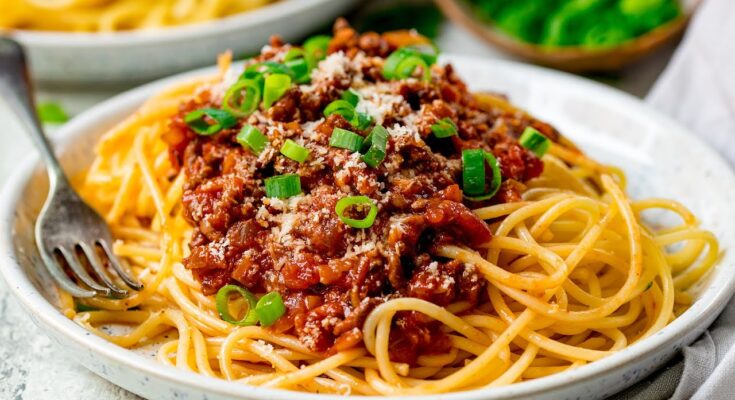Beef Bolognese Recipe: If you’ve ever craved a hearty, comforting dish that fills your kitchen with rich aromas and warms your soul, then beef Bolognese is the recipe you need. This traditional Italian sauce, slow-cooked to perfection, is not just a simple pasta topping—it’s a masterpiece of flavors. With layers of ground beef, fresh vegetables, herbs, and a tomato base, it’s the kind of recipe that makes you slow down, savor every bite, and maybe even go back for seconds.
This guide will take you through every step of making beef Bolognese, from selecting the best ingredients to achieving that perfect balance of flavors. Whether you’re a beginner or an experienced cook, this step-by-step recipe will help you master this timeless dish with ease.
What is Beef Bolognese?
Beef Bolognese, often referred to as “ragù alla Bolognese,” is a traditional Italian meat-based sauce originating from Bologna, a city in northern Italy. Unlike the quick pasta sauces many of us are used to, Bolognese is all about patience. It’s cooked slowly, allowing the flavors of the meat, vegetables, and wine to meld together into something truly special.
Unlike a standard tomato-based pasta sauce, authentic Bolognese is less about tomatoes and more about meat and depth of flavor. It usually contains a combination of ground beef, onions, carrots, celery, wine, milk or cream, and just enough tomato to balance everything out. The result is a rich, savory sauce that clings beautifully to pasta.
History and Origin of Bolognese Sauce
The story of Bolognese goes back centuries. It is said that Pellegrino Artusi, one of Italy’s first celebrated cookbook authors, published a version of the recipe in the 19th century. Originally, it wasn’t served with spaghetti (that’s more of an American twist). Instead, in Bologna, the sauce is traditionally paired with tagliatelle, a wide and flat pasta that holds the sauce perfectly.
Over time, Bolognese has traveled the world and evolved. Today, you’ll find countless variations—some more authentic, some adjusted to local tastes. But at its heart, Bolognese is a celebration of slow cooking and simple, quality ingredients.
Why This Recipe Stands Out
So why this recipe? Because it balances authenticity with practicality. We stick to the traditional roots but make it easy enough to prepare in your home kitchen. It’s hearty, flavorful, and versatile—you can serve it with pasta, use it in lasagna, or even enjoy it with a crusty piece of bread. This step-by-step guide will ensure you get the rich, layered flavors of a true Bolognese sauce without feeling overwhelmed in the kitchen.
Ingredients You’ll Need
Main Ingredients for Beef Bolognese
Here’s what you’ll need for the base of your sauce:
- Ground beef – Use a mix of lean and fatty beef for a perfect balance of flavor and richness.
- Onion – Finely chopped for sweetness and depth.
- Carrots – Add natural sweetness and balance the acidity of tomatoes.
- Celery – Essential for building flavor in the sauce.
- Garlic – A couple of cloves for aromatic richness.
- Tomato paste – Concentrated flavor that deepens the sauce.
- Canned tomatoes or passata – To create the body of the sauce.
- Beef stock – For richness and depth.
Fresh Herbs and Seasonings
Seasoning makes all the difference. You’ll need:
- Olive oil – For sautéing vegetables and beef.
- Salt and pepper – To bring out the natural flavors.
- Bay leaves – Add subtle earthy notes.
- Fresh thyme or rosemary – For aroma.
- Nutmeg – A pinch for a traditional Italian touch.
Optional Additions for Extra Flavor
Want to elevate your Bolognese? Consider:
- Red or white wine – Adds acidity and complexity (red for richness, white for a lighter touch).
- Milk or cream – Softens the acidity of tomatoes and makes the sauce velvety.
- Parmesan cheese rind – Simmer it in the sauce for incredible umami.
- Mushrooms – Add earthiness and depth.
Kitchen Tools You’ll Need
Must-Have Cooking Equipment
To make this dish efficiently, you’ll need:
- Large heavy-bottomed pot or Dutch oven – Essential for slow cooking.
- Sharp chef’s knife – For finely chopping vegetables.
- Wooden spoon – Perfect for stirring without scratching your pot.
- Measuring cups and spoons – To keep flavors balanced.
Helpful Tools to Speed Up Cooking
While not strictly necessary, these can make things easier:
- Food processor – Speeds up chopping vegetables.
- Grater or microplane – For grating fresh Parmesan or nutmeg.
- Ladle – Handy for skimming or serving.
Having the right tools ensures cooking doesn’t feel like a chore and allows you to focus on bringing out the best flavors.
Step-by-Step Guide to Making Beef Bolognese
Step 1 – Preparing the Vegetables
Start with the flavor base known in Italian cooking as soffritto—a mix of finely chopped onion, carrot, and celery. This trio is the heart of many Italian sauces, and it sets the foundation for your Bolognese.
Finely dice the vegetables so they blend seamlessly into the sauce rather than standing out as chunks. Heat olive oil in your pot, then add the vegetables and cook them slowly over medium heat until they soften and release their aroma. Don’t rush this step—let them sweat gently for about 10 minutes. This slow cooking caramelizes the natural sugars, giving your Bolognese a subtle sweetness.
Adding garlic toward the end prevents it from burning. Once the vegetables are golden and fragrant, you’re ready to move on to the beef.
Step 2 – Cooking the Ground Beef
Once your soffritto is ready, it’s time to build the meaty base of the sauce. Add your ground beef to the pot, breaking it up with a wooden spoon as it cooks. The key here is patience—don’t just brown the meat lightly; let it cook long enough to develop deep flavors. You want the beef to caramelize slightly, which brings out richness and a slightly nutty undertone.
Avoid overcrowding the pot. If you add too much meat at once, it will steam rather than brown, leaving you with a bland base. If needed, cook the beef in batches, removing portions once browned before adding more. This small extra step makes a huge difference in flavor.
As the beef cooks, season with salt and pepper. This not only enhances the meat’s flavor but also ensures every bite of your Bolognese is well-balanced. Once the beef is browned, mix it with the soffritto. At this stage, your kitchen should be filled with incredible aromas—this is the moment when Bolognese starts taking shape.
Step 3 – Adding Tomato Base and Herbs
With the beef and vegetables perfectly cooked, it’s time to add the heart of the sauce: tomatoes and herbs. Start by stirring in tomato paste. Cook it for a few minutes before adding any liquid—this helps remove its raw edge and intensifies its deep, savory flavor.
Next, pour in your canned tomatoes or passata. Crush whole tomatoes with the back of your spoon to release their juices. This tomato base adds body and tanginess, balancing the richness of the meat.
Now, season with bay leaves, fresh thyme or rosemary, and a touch of nutmeg. These herbs add complexity, turning your sauce from ordinary to extraordinary. At this stage, if you’re using wine, pour it in and let it simmer until the alcohol evaporates. This step infuses the sauce with a subtle acidity that brightens the flavors.
Finally, pour in beef stock for richness. Stir everything well, making sure the flavors meld together. Already, your Bolognese is starting to look like the real deal.
Step 4 – Simmering for Maximum Flavor
This step is where the magic happens. Authentic Bolognese is not about quick cooking—it’s about letting the sauce slowly develop layers of flavor. Lower the heat and allow the sauce to simmer gently for at least 1.5 to 2 hours. Some Italians simmer their ragù for up to 4 hours, and the longer it cooks, the deeper the flavors become.
Keep the pot partially covered, letting steam escape but preventing too much liquid loss. Stir occasionally to keep the sauce from sticking to the bottom. If it looks too dry, add a splash of water, stock, or even a little milk. Milk is a traditional addition that mellows the acidity of tomatoes and makes the sauce velvety smooth.
During this slow cooking, the beef breaks down, the vegetables dissolve into the sauce, and the herbs infuse every bite. By the end of the simmering process, you’ll have a thick, rich, and flavorful Bolognese that clings beautifully to pasta.
Step 5 – Final Touches Before Serving
After hours of simmering, your sauce is nearly ready, but a few final touches will make it unforgettable. First, taste it. Adjust the seasoning with salt and pepper, or add a pinch of sugar if the tomatoes are too acidic.
For an extra creamy texture, stir in a splash of cream or a knob of butter just before serving. This gives the sauce a luxurious finish. If you added a Parmesan rind during simmering, remove it now, but don’t forget to grate fresh Parmesan over your dish when serving.
Your beef Bolognese should be rich, hearty, and fragrant. Spoon it generously over freshly cooked pasta, top with Parmesan, and garnish with fresh basil or parsley. At this point, you’ll have created not just a meal but an experience—one that will make your family or guests ask for seconds.
Serving Suggestions
Best Pasta to Pair with Bolognese
Traditionally, Bolognese is served with tagliatelle, a wide ribbon-like pasta that holds the sauce perfectly. If you can’t find tagliatelle, pappardelle or fettuccine are great alternatives. These flat noodles allow the thick, rich sauce to coat every strand.
While spaghetti Bolognese has become popular worldwide, especially outside of Italy, true Italians would argue that spaghetti doesn’t hold the sauce as well. However, if spaghetti is what you have, it will still taste fantastic—just make sure to toss the pasta with the sauce rather than piling it on top.
Side Dishes That Complement Beef Bolognese
Pair your Bolognese with simple yet flavorful sides:
- Garlic bread – Perfect for scooping up leftover sauce.
- Fresh green salad – A crisp salad with vinaigrette balances the richness.
- Steamed vegetables – Broccoli or green beans add freshness.
- Roasted vegetables – Caramelized carrots, zucchini, or bell peppers complement the flavors beautifully.
Garnishing Tips for a Restaurant-Style Presentation
For a final flourish, garnish your plate with freshly grated Parmesan cheese, a drizzle of extra virgin olive oil, and a sprinkle of finely chopped parsley or basil. Serve with a glass of red wine for a true Italian dining experience. Presentation matters—after all, we eat with our eyes first!
Tips and Tricks for the Perfect Beef Bolognese
How to Achieve Rich Flavor
A truly unforgettable Bolognese depends on layering flavors step by step. Start by caramelizing your vegetables slowly, then browning your beef thoroughly until it develops a deep golden crust. Don’t skip deglazing the pan with wine—this not only lifts all those flavorful browned bits stuck to the bottom of the pot but also adds complexity. Another insider tip is to use a mix of beef and pork instead of beef alone. Pork adds natural sweetness and tenderness that balances the richness of the beef.
Long, slow cooking is the real secret weapon. Letting your sauce simmer for hours allows the flavors to deepen and meld together beautifully. Add milk or cream toward the end to smooth out acidity and create a luxurious texture. Finally, always taste and adjust the seasoning before serving—it’s the difference between a good Bolognese and a great one.
Common Mistakes to Avoid
Many people make small mistakes that prevent their Bolognese from reaching perfection. The first is rushing the cooking process—good Bolognese is never a quick meal. Another common error is adding too many tomatoes. Remember, authentic Bolognese is meat-forward, with tomatoes playing a supporting role.
Avoid using lean beef only, as it can make the sauce dry. A mix of lean and fatty beef gives a much better balance. Don’t forget the soffritto either; skipping this base will leave your sauce flat and lacking depth. Finally, resist the temptation to overload with herbs and spices. A true Bolognese relies on simplicity, allowing each ingredient to shine.
Storage and Reheating Tips
One of the best things about Bolognese is that it tastes even better the next day. Once cooled, store it in an airtight container in the fridge for up to 4 days. For longer storage, freeze in portions—perfect for quick weeknight dinners.
To reheat, warm it gently on the stove with a splash of water, stock, or milk to revive its silky texture. Avoid microwaving in large batches, as it can dry out the sauce unevenly. Instead, heat in smaller portions for the best results.
Variations of Beef Bolognese
Classic Italian Style
The most authentic Italian Bolognese, also called ragù alla Bolognese, is made with a mixture of ground beef and pork, soffritto, tomato paste, wine, and milk. It’s simmered slowly until the sauce is rich and velvety. Unlike the American-style spaghetti Bolognese, it’s served with tagliatelle or used in traditional dishes like lasagna.
Healthier Alternatives
If you want to enjoy Bolognese with fewer calories, try using ground turkey or chicken instead of beef. You can also bulk up the sauce with extra vegetables like mushrooms, zucchini, or bell peppers. Using olive oil sparingly and substituting cream with low-fat milk can also lighten up the dish without sacrificing too much flavor.
For those on a low-carb diet, skip the pasta and serve your Bolognese over zucchini noodles, spaghetti squash, or even cauliflower rice. The rich, meaty sauce pairs beautifully with all these alternatives.
Spicy Twist for Extra Kick
Love bold flavors? Add a spicy twist to your Bolognese. Toss in red pepper flakes, chopped chili peppers, or even a splash of hot sauce to give your sauce some heat. For a smoky kick, try adding a touch of smoked paprika. This variation pairs especially well with short pasta like rigatoni, which captures the sauce beautifully.
Nutritional Value of Beef Bolognese
Calories and Macronutrients
A traditional serving of beef Bolognese with pasta is a hearty meal. On average, one serving (without pasta) contains around:
- Calories: 250–350
- Protein: 20–25g
- Fat: 15–20g
- Carbohydrates: 10–15g
The exact numbers depend on the type of meat, cooking fat, and whether you add cream or milk.
Vitamins and Minerals
Bolognese isn’t just tasty—it’s packed with nutrients. The beef provides iron, zinc, and vitamin B12, which are essential for energy and red blood cell production. The vegetables add fiber, vitamin C, and potassium, while the tomatoes are rich in lycopene, a powerful antioxidant.
Making It Healthier Without Losing Flavor
You can boost the health factor of your Bolognese by making a few simple tweaks:
- Use lean beef or a beef-pork mix with lower fat.
- Add more vegetables like mushrooms, carrots, or spinach.
- Cut back on cream and butter—use low-fat milk instead.
- Serve smaller pasta portions and increase vegetable sides.
This way, you get a dish that’s satisfying, nourishing, and still delicious.
FAQs about Beef Bolognese Recipe
Can I Make Beef Bolognese Ahead of Time?
Absolutely! In fact, Bolognese tastes even better when made in advance. The flavors develop and deepen as the sauce rests. You can prepare it a day ahead, store it in the fridge, and simply reheat it when ready to serve.
Can I Freeze Beef Bolognese?
Yes, Bolognese freezes beautifully. Allow it to cool completely, then store it in airtight containers or freezer bags for up to 3 months. Thaw overnight in the fridge and reheat gently on the stove for best results.
What’s the Difference Between Bolognese and Spaghetti Sauce?
Spaghetti sauce is usually tomato-heavy, quick to prepare, and often seasoned with lots of herbs. Bolognese, on the other hand, is meat-focused, slow-cooked, and has just enough tomato to balance the flavors. It’s richer, creamier, and more complex than a standard pasta sauce.
Can I Use Fresh Tomatoes Instead of Canned?
Yes, but make sure they’re ripe and juicy. Blanch and peel them before adding, or chop them finely. Fresh tomatoes give a lighter flavor, but canned tomatoes usually provide a more consistent taste year-round.
What Pasta Works Best with Bolognese?
Traditionally, tagliatelle is the pasta of choice. Its wide ribbons hold the thick sauce beautifully. However, pappardelle, fettuccine, and rigatoni are also excellent choices.
Conclusion
Beef Bolognese is more than just a pasta sauce—it’s a dish that brings comfort, warmth, and a little taste of Italy into your kitchen. With its rich layers of flavor, hearty texture, and endless versatility, it’s the kind of recipe that deserves a spot in every home cook’s collection.
By following this step-by-step guide, you’ll not only master the art of making authentic Bolognese but also impress anyone lucky enough to share a plate with you. Whether served with traditional tagliatelle, layered into lasagna, or paired with garlic bread, this sauce is always a crowd-pleaser.
So, the next time you want to cook something truly satisfying, take your time, follow these steps, and enjoy the magic of a homemade Beef Bolognese.



